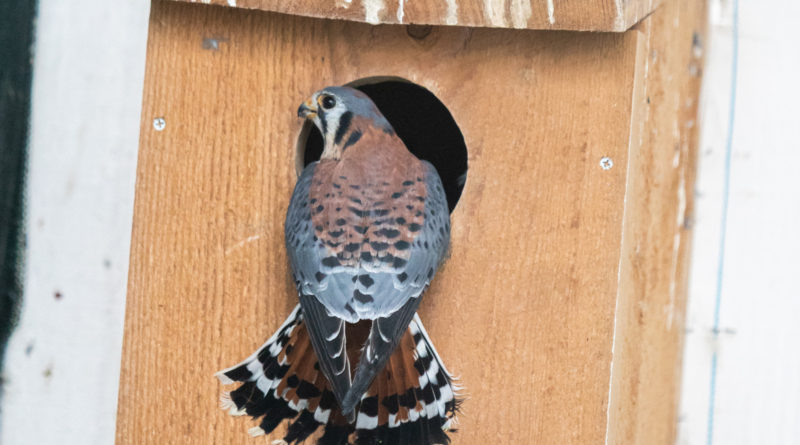Rescuing raptors: Nesting boxes offer fresh solution for cavity dwellers
As numbers come in from a variety of Christmas bird counts throughout the state, a disturbing trend is materializing.
“While the number of species we observed is good — the numbers of the birds are declining,” said naturalist Jon Beam, of the Montour Preserve.
The reason for the decline — especially those in songbirds — is still a mystery.
“I think it comes down to a combination of things over a period of time, including use of pesticides, changes in the weather patterns over the past couple years and loss of habitat.”
The last of those theories ties directly into a new project by Snyder County falconer Mike Dupuy to supply nesting boxes for cavity-dwelling raptors.
“Many people cut down cavities — like those found in old, dead trees — without thinking of the natural consequences,” he said. “I’m encouraging people to replace those lost cavities with nesting boxes for two raptors that are known cavity-dwellers — screech owls and kestrels.”
Kestrels
Once known as sparrow hawks, kestrels are the state’s smallest falcon species. They are diurnal — active during the day — and thrive in open fields and field edges.
“They eat a lot of small rodents, and in the summer can supplement that diet with grasshoppers, beetles and sometimes small birds — so they are good to have around,” said Beam. “They’re numbers are really down in the southeast port of the state where farmer’s fields are being replaced with housing developments and shopping centers.”
Locally, they’re still fairly prevalent, Dupuy added.
“I’ve seen them along Route 45,35 and anywhere there is uncultivated farmland, including hayfields,” he said. “Their diet can be a natural way to control rodent, insect and unwanted bird populations, so it can make sense for farmers to put up a few extra boxes and encourage them to come in.”
Among the kestrel’s “supernatural” powers, according to Dupuy, are the abilities to see the urine of rodents in inferred spectrum and to hover while looking for prey.
“They can see the color of the urine, so they can hone in on the areas where rodents are exiting their hiding places to urinate and defecate,” he said. “Imagine some creature hovering over your Porta-potty, and the moment you come out — whack!”
The short-term hovering ability helps in hunting, Beam added.
“Sometimes, as they fly over a field and lose sight of a potential meal, they can flap their wings very quickly and hover in the air for a minute or two,” he said. “Which is usually long enough to pick up the trail of their prey.”
Males are typically more colorful than females, with blues, whites and a brick-like red hue, Dupuy said, adding that they have a black stripe running vertically below the eye — a characteristic of all falcons.
“Adult males typically have a grayish wing, while the females usually have brown wings,” said Beam.
Screech owls
Unlike kestrels — screech owls function mostly at night (nocturnal), but can also be crepuscular in habit (hunting during the dawn and dusk timeslots), partially because one of their biggest threats are great horned owls.
“If they live in the same area as great horned owls, they’ll adjust their timelines so they aren’t out when the great horned owls are most prevalent,” said Beam.
Screech owls can function like chameleons in that their coloration and feather structure allow them to blend into their backgrounds.
“The tufts on their heads that people assume are ears actually are for camouflage purposes,” said Dupuy. ‘They also can elongate their bodies if frightened, and can look like a broken branch. I’ve been within a few feet of a screech owl and not been able to find them.’
Because of their ability to blend in, people are more likely to hear screech owls than see them.
“They can make a very eerie, haunting sound, that I always likenedd to horses whinnying,” said Dupuy.
“Like a high-pitched horse whinny,” Beam said. “Except you don’t find many horses up in trees.”
Screech owls offer a variety of other vocalizations, and can mimic some of the birds around them.
Another key to finding them is to watch other bird species in the area, suggested Dupuy.
“Wrens, chickadees and other song birds usually get very agitated when a screech owl is around,” he said.
Like other owl species, Beam added, screech owls keep one mate throughout their lives.
“Even though they can be apart for part of the year, the same pair will come back during courtship time — unless something happens to one of them” he said.
Cavity caution
Both birds, regardless if they are active day or night, rely on cavities created by others.
“They can’t make the cavities on their own — they depend on holes created by woodpeckers or other natural means,” said Beam.
Which is why Dupuy continues to market nesting boxes.
“We live in a world where most everyone has a chainsaw, and people have this tendency to want to tidy up nature,” he said. “Sometimes, it is necessary to take down a dead tree — and in those cases, consider putting up a box.”
For more information, visit www.mikedupuyhawkfood. com

